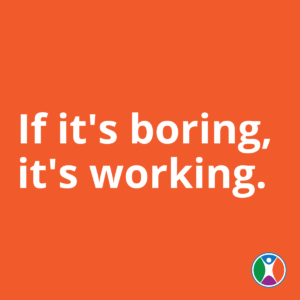When communication stops, performance atrophies. When communication is constant, performance improves.
Every organization has a rhythm or cadence to their internal communication—even if it’s not ideal. What differentiates high performance organizations from the rest is their communication infrastructure. This infrastructure allows them to stay strategically aligned because it keeps everyone focused on the organization’s highest priority goals and uses data to ensure that actual performance meets the established expectation. A solid communication infrastructure allows the teams to be proactive and triggers accountability and engagement at every level of the organization.
To be successful, you must first know how to align goals, set indicators, and measure performance. Once you’ve established a plan, communicate it clearly to your team. Everyone in your organization should understand the priorities and their role in accomplishing them. You’ll use this communication infrastructure to determine whether you are underperforming, on target, or exceeding expectations.
Communication starts with employees doing their jobs
The employee is the foundation of your communication infrastructure. High performance organizations set employees up for success based on what’s expected of them. They do this by ensuring that everyone has the tools and information they need to do their jobs correctly, without wasting time searching for what they need.
Every employee understands the team’s priorities and tracks how time is spent, then compares it to their daily goals and expectations using a work center monitor. If he or she does not have the resources needed to accomplish these tasks, it is the employee’s responsibility to communicate that.
Team huddles or shift meetings happen daily
Whatever you like to call them, this is how your teams communicate. For five to ten minutes, team members have a quick meeting to discuss their action plan. They highlight the previous day’s activities and accomplishments and discuss their plan for the day.
The purpose of this meeting is to ensure that each member of the team has a solid plan and workload and that their daily actions are in alignment with organizational goals. Here the team reviews their priorities and ensure that the priorities they spend time working on are what they, as a team, have promised to deliver.
The team has a weekly performance briefing
This is a 30-minute meeting where the team reviews their visual controls and uses data to evaluate their performance for the week. They may discuss cross training or scorecard performance trends. Ultimately, they are comparing expectations to reality and finding causes and solutions to performance issues using the data generated by each employee in the work center monitor.
The purpose of this meeting is to look at their work center monitors and identify data trends that indicate a performance issue. By using data, they’re able to prioritize which issues are most significant and either solve the issue or create a priority project and initiate a problem-solving team (more on these folks later) who will work to resolve the issue.
The team supervisor and manager meet regularly
At this meeting, the performance data generated by the employees and discussed by the teams is communicated up a level to the department managers. The team supervisor summarizes the team’s data and lists significant facts and actions for the management team to review.
The purpose of this meeting is for team supervisors and managers to review team priorities and provide resources where needed so the teams can do their jobs and perform better.
Managers meet with upper management
Managers share their findings from the team supervisor meeting with upper management and discuss what’s needed from the leadership team to improve performance. Upper management decides and that decision is communicated back down the chain, using the same communication infrastructure, until the employees get what they need to do their jobs and improve performance.
A dedicated problem-solving team is necessary
When the team encounters an issue that they cannot remedy on their own, a cross functional problem-solving team will step in. These folks utilize a standard problem-solving process, which has its own communication infrastructure, to fix issues and improve performance. Following this standard problem-solving process is crucial because it ensures that the solutions developed in line with organizational goals. Many times, what many appear to be a solution is actually just a work around in disguise, which can degrade team performance over time.
Commonality in communication
All the information being shared in these meetings is aligned. The only thing that changes is the perspective from which it is evaluated. As the data moves through the communication infrastructure, it becomes higher level by nature. But if upper management wants to drill down into details, all that is needed is a look at the reports generated at the lower levels. The point of a communication infrastructure is to ensure that everyone is speaking a common language: actual performance as it relates to organizational goals.

If it’s boring, it’s working
That’s the thing about communication. When everyone is in clear communication, there are fewer mistakes, fewer issues, and fewer things to talk about.
It’s precisely this trap that prevents so many companies from being high-performance organizations. People will start to wonder why they’re wasting time having these meetings since nothing is being discussed. And over time, they’ll stop having meetings. And communication and performance will atrophy. No machine runs flawlessly forever. Maintaining a solid communication infrastructure ensures that you catch small problems before they become a bigger performance issue. Never lose the value of this face-to-face contact.
The Dorsey Group exists to help you become the most productive, profitable organization you can be. Our results-oriented performance improvement initiatives include Strategic Alignment, High Performance Work Teams, Organizational Development, Organizational Analysis and Problem Solving.
The Dorsey Group can help unleash your team’s potential and power peak performance. For more information, contact us at www.TheDorseyGroup.org or (954) 629-5774.

